
1n the 1920's, gangsters weren't people involved in gangs and shootings. People were considered to be gangsters if they went against Prohibition and bought alcohol to consume. Jay Gatsby was involved in this in the book. He is therefore considered a gangster. This is ironic, however, because he doesnt seem like a typical gangster. He is well put together and has a good image. Many wealthy people were involved in this because they could afford the crazy prices of alcohol.

"Jay Gatsby effectively overturned the dated assumption that gangsters were lowlifes from the Bowery and replaced it with an upscale figure who was enviably wealthy and fashionably stylish. Significantly, this portrayal was an outgrowth of actual changes in existing criminal conditions. Fitzgerald understood better than Asbury that since the advent of Prohibition, gangsters were, in fact, on the rise; not only were they gaining more wealth and power, but they were presuming to status and respectability as well. If Fitzgerald's Gatsby was solidly grounded in these historical developments, he too came perilously close to being an implausible gangster and a distortion of fact. Though readers still find Gatsby too romantic, too idealistic, and too naive to be a criminal success, Fitzgerald counteracted this impression by cloaking his gangster in mystery, then frustrating Nick's efforts to penetrate it, and finally suggesting that Gatsby, like Asbury's dandy, may be more dangerous than Nick realizes. If this elusive figure involved a significant modification of the actual gangsters on which Fitzgerald was drawing, he was not the specious fabrication that Asbury was decrying. To characterize Gatsby as a "dandy" might seem inappropriate since clothing is rather incidental to his depiction. This quality is communicated to Nick more by his other possessions than by his white suit, silver shirt, and gold tie-his palatial house, his grand parties, his fancy automobile, his hydroplane, and his library of real books. His flourish of expensive shirts late in the novel merely embellishes this image. This Gatsby is an ideal consumer in his expenditure of so much on the nonessential. He is a dandy who buys expensive merchandise to take on its desirability and to convince Daisy of his worthiness. These traits confirm the potency of a consumer culture and illuminate the social instability generated by the age's myriad products and aggressive advertising. The new credit economy of the 1920s accelerated social mobility and empowered a new ethos whereby merchandise rivaled background, profession, and merit as a determinant of status." (http://www.highbeam.com/doc/1G1-14769861.html) 










75/75
ReplyDelete